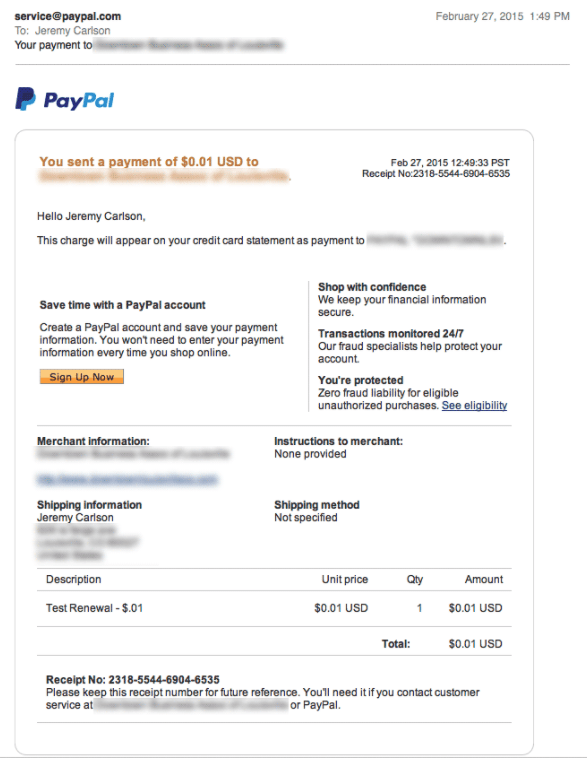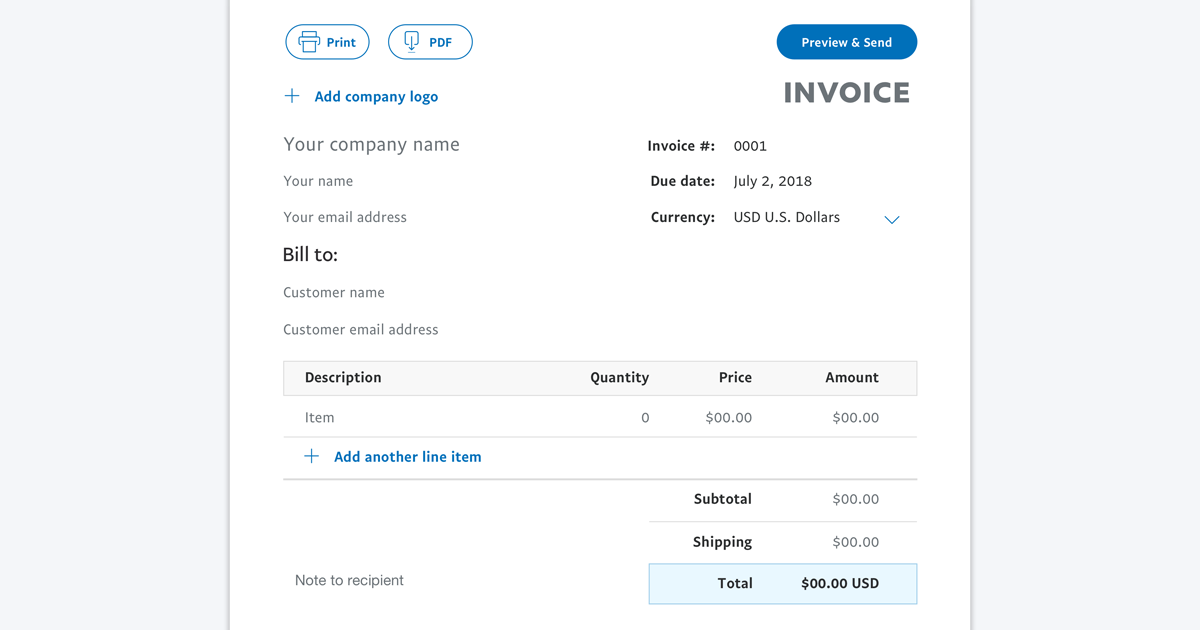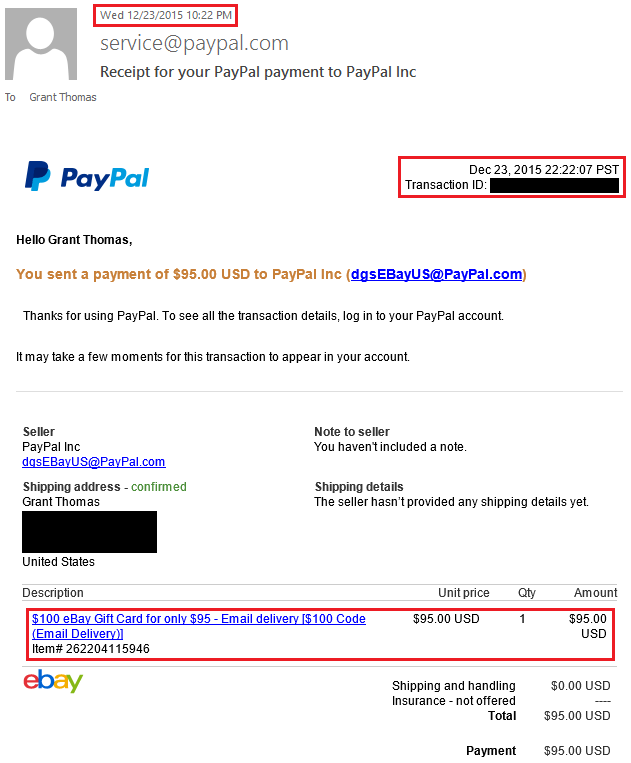PAYPAL

Transaction Details

Transaction ID: 8UN4567890

Date: 2024-05-10
Time: 12:34:56 PM
Status: Completed
Payer: John Smith
Payment to: Mary Jones
Amount: $100.00 USD
Fee: $0.00 USD
Net Amount: $100.00 USD
Payment Method: PayPal Balance
Note: Payment for services rendered.
IMPORTANT NOTICE: This receipt is not a tax invoice. If you require a tax invoice, please contact the recipient.
PayPal, Inc.
1450 N 1st St
San Jose, CA 95131
United States## Fake Receipt Paypal
Executive Summary
Online fraud has become a significant concern for businesses and individuals alike. One common form of fraud is the use of fake receipts, particularly when using payment platforms like PayPal. This article aims to provide comprehensive information about fake PayPal receipts, including their identification, prevention, and reporting mechanisms.
Introduction
PayPal is a widely used online payment platform that facilitates transactions between individuals and businesses. Unfortunately, like any online platform, PayPal is not immune to fraud. Fake PayPal receipts are a devious tactic used by fraudsters to deceive unsuspecting victims into making payments or divulging sensitive information.
FAQs
Q: What are fake PayPal receipts?
A: Fake PayPal receipts are fraudulent documents that mimic legitimate PayPal receipts. They can be used to deceive victims into believing that a payment has been made or received via PayPal, when in reality, no such transaction has occurred.
Q: How can I identify fake PayPal receipts?
A: Here are a few telltale signs of fake PayPal receipts:
- Mismatched email addresses
- Inconsistent transaction details
- Poor grammar and spelling
- Unfamiliar sender names
- Suspicious links or attachments
Q: What should I do if I receive a fake PayPal receipt?
A: If you receive a fake PayPal receipt, it’s crucial to report it to PayPal immediately. You can also contact your bank or credit card company to dispute any unauthorized transactions.
Subtopics
1. Understanding PayPal Fraud
PayPal fraud encompasses various fraudulent activities that aim to exploit the platform or its users. Fake receipts are a common form of PayPal fraud, but there are other types, such as phishing emails, account takeovers, and unauthorized charges.
Important Considerations:
- Phishing emails often mimic legitimate PayPal communications but contain malicious links or attachments.
- Account takeovers occur when fraudsters gain access to victims' PayPal accounts to make unauthorized transactions.
- Unauthorized charges refer to fraudulent purchases made using stolen or compromised PayPal accounts.2. Types of Fake PayPal Receipts
Fraudsters create fake PayPal receipts for various purposes. Some common types include:
- **Payment receipts:** These receipts indicate that a payment has been made, typically to the fraudster's account.
- **Refund receipts:** These receipts suggest a refund has been issued, often used to trick victims into providing bank details.
- **Invoice receipts:** These receipts are designed to appear as invoices from legitimate businesses, tricking victims into paying for fictitious goods or services.3. Prevention Techniques
Preventing fake PayPal receipts requires vigilance and awareness. Here are some measures to consider:
- **Verify sender email addresses:** Always confirm that the email address of the sender matches the expected PayPal address.
- **Review transaction details:** Carefully examine the transaction details, including the amount, recipient, and purpose of the payment.
- **Check for suspicious links or attachments:** Avoid clicking on links or opening attachments in suspicious PayPal receipts.
- **Use strong passwords:** Utilize strong and unique passwords for your PayPal account and regularly change them.
- **Monitor your PayPal activity:** Regularly check your PayPal transaction history for any unauthorized or suspicious activity.4. Reporting Mechanisms
If you suspect you have received a fake PayPal receipt, it’s essential to report it immediately. You can do so through the following channels:
- **PayPal:** Report the receipt to PayPal's customer service team via email, phone, or online chat.
- **Law enforcement:** If you believe the fraud is a criminal offense, you can report it to local law enforcement agencies.
- **Anti-phishing working group:** Report phishing emails and other suspicious activities to the Anti-Phishing Working Group (APWG).5. Consequences of Fake PayPal Receipts
Fake PayPal receipts can have severe consequences for both individuals and businesses. Some potential impacts include:
- **Financial loss:** Victims may lose money due to unauthorized charges or fraudulent payments.
- **Reputation damage:** Businesses may suffer reputational damage if fake receipts are used to impersonate their brand.
- **Account compromise:** Fraudsters may gain access to victims' PayPal accounts, leading to further financial losses.
- **Legal liability:** Individuals and businesses may face legal repercussions if they unknowingly participate in fraudulent activities involving fake receipts.Conclusion
Fake PayPal receipts are a growing concern, highlighting the importance of vigilance and awareness when conducting online transactions. By understanding the different types of fake receipts, implementing preventive measures, and reporting suspicious activity promptly, individuals and businesses can minimize the risk of falling victim to PayPal fraud. Remember, staying informed and taking proactive steps can help protect you from these devious schemes.
Keyword Tags
- Fake PayPal Receipts
- PayPal Fraud
- Prevention Techniques
- Reporting Mechanisms
- Consequences of Fake Receipts
